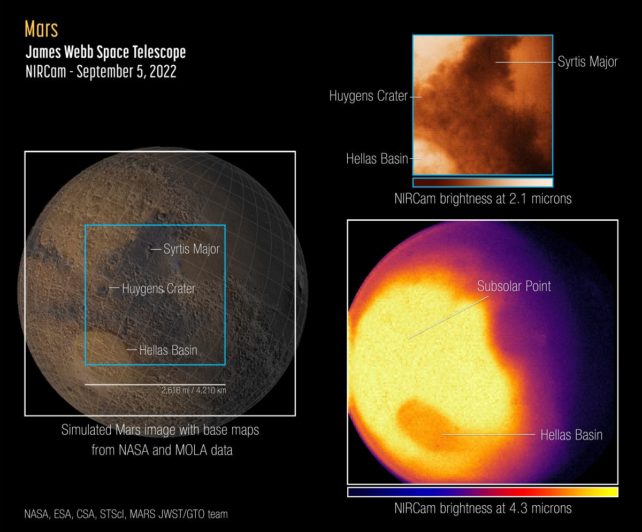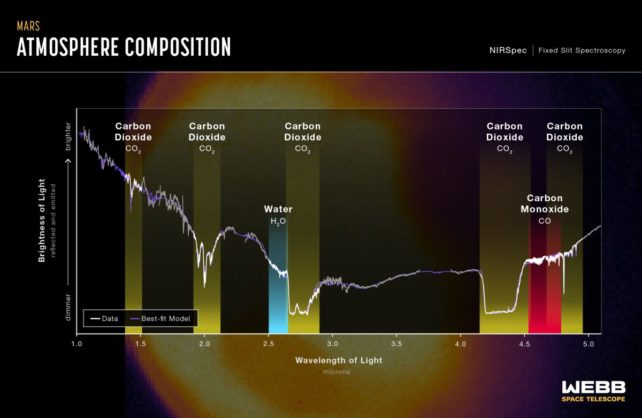The James Webb Space Telescope has made incredible headway, peering farther across space and time than any telescope that came before. But it's also showing us the Universe closer to home… and now it's turned its gold-plated eye to Earth's next-door-neighbor, Mars.
The resulting images show Mars in a very different light – infrared, in fact – giving us information about the red planet that we wouldn't be able to see with our own naked eyes.
Given that heat lets off infrared light (what we call thermal radiation), a lot of that information is about the temperature of Mars, but there are a few other tidbits that scientists will be able to use to better understand a planet so like, but so very unlike, our own.
And, of course, the view is spectacular.
It's actually somewhat tricky for JWST to image something close to home. It's the most powerful telescope ever launched into space, designed to be sensitive enough to detect the extraordinarily dim light from the most distant objects in the Universe. Compared to these, Mars blazes like a furnace.
To avoid the oversaturation that would usually result from this brightness, the scientists taking the observations and processing the data had to employ techniques to compensate. The timing of the exposures was incredibly short, and data analysis was adjusted accordingly.

The result was worth it: a map of the side of Mars viewed by the telescope in two wavelengths of infrared light. At 2.1 microns, the image is dominated by sunlight reflecting off the surface of Mars, so what we see is very similar to what we might see in optical wavelengths.
At 4.3 microns, the image is dominated by thermal radiation from the Martian atmosphere, brightest where the Sun is almost directly in line with the planet. This is generally where a planetary atmosphere is warmest.
But heat isn't the only source of infrared light at this wavelength. A dark smear can be seen towards the bottom right of the brightest region in this wavelength; this is actually produced by a feature on the surface of Mars. It's a huge impact basin called Hellas Planitia – it's one of the largest craters on Mars, and the entire Solar System.
The atmosphere on Mars is 96 percent carbon dioxide, which absorbs light. And the atmosphere is thicker enough over the Hellas Planitia for this to have an observable effect in infrared wavelengths.

"This is actually not a thermal effect at Hellas," says astronomer Geronimo Villanueva of NASA's Goddard Space Flight Center, who designed the observations.
"The Hellas Basin is a lower altitude, and thus experiences higher air pressure. That higher pressure leads to a suppression of the thermal emission at this particular wavelength range [4.1-4.4 microns] due to an effect called pressure broadening. It will be very interesting to tease apart these competing effects in these data."
He is referring to the near-infrared spectrum of Mars, which shows a finer, more detailed breakdown of the composition of the planet's atmosphere and surface, as specific wavelengths are muted or amplified by the absorption and re-emission of light by specific molecules.
So far, scientists have easily been able to identify carbon dioxide, carbon monoxide, and water in the Martian atmosphere.
However, analysis is ongoing, and we won't know what details these new data reveal until the team is ready to release their findings in a published paper, which they are currently working on. That will need to undergo the peer review and publication process, but we're excited to learn what new information the amazing telescope can reveal about such a well-studied planet.
